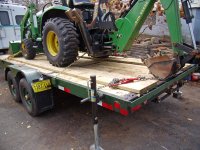Dmace
Elite Member
The WD hitch takes 5 minutes longer to hookup since you have to connect the trailer (requires lowering and connecting to ball) You have to do this with any trailer so that cannot count against the extra time needed to hook up a WD hitch. Unless you have a trailer that does not require "lower and connecting to ball"... :laughing:
take weight off ball by jacking trailer back up while hooked to truck,
I don't get why people do this, you do not need to jack up the trailer after it's connected to the truck. You can just as easily connect the stabilizer bars BEFORE lowering the trailer onto the truck.
connect the WD arms,
and then lowering the trailer back down (winding tiongue jack up).
Again, unnecessary step if you know what you are doing.
Note that you will need to remove the WD arms if driving the truck/trailer without the tractor since it will lighten your truck rear.
It can't take more than 30 seconds to remove them anyways but you can just as easily leave them on. You could even set the chain at a lower link which is even easier than removing them.
Also when unloading the trailer the WD hitch will make your truck rear lift more when the tractor drives off the trailer -- definitely block the rear of the trailer so it does not lift the truck.
When I unloaded my tractor off the trailer it did not lift the truck at all. The chains/stabilizer bars stop the tongue from going down but do not stop it from going up, that's why it's a chain and not a solid bar. The front of the trailer went up just as much as normal while unloading and the chains slacked as the bars didn't move but there is no way it would have lifted the truck. Again if it does, it would take about 20 seconds to remove the chains from the mounts and leave the bars on the hitch.
See RED text for my responses.


